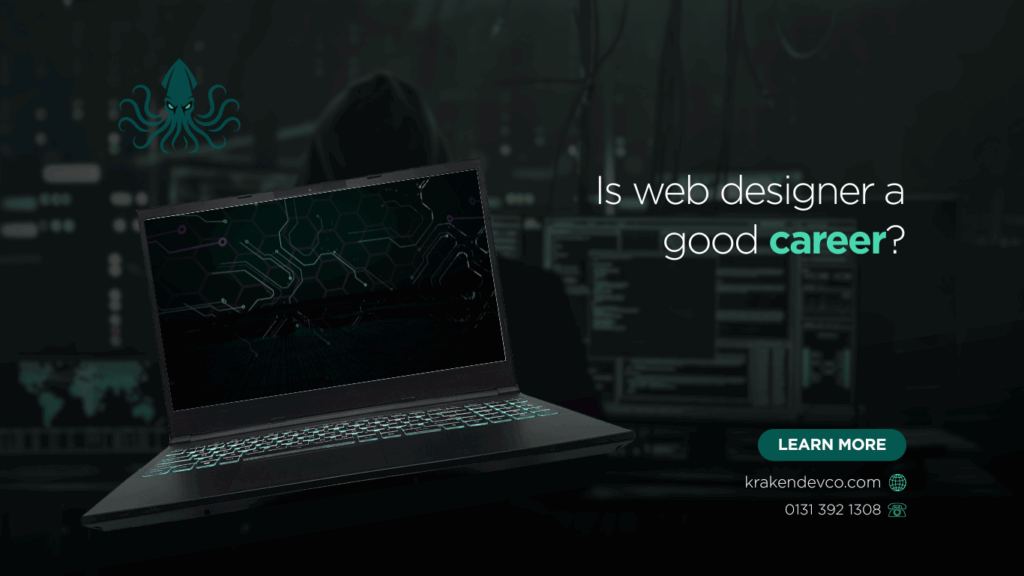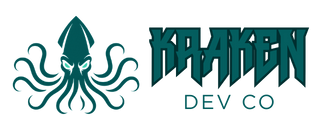
Have you ever looked at a beautiful website and thought, “Someone actually designed this—could I do that?” If so, you’re not alone. Thousands of people each year consider web design as a career move, whether they’re coming from creative fields, tech adjacent roles, or starting fresh. But is web design still a good career in 2025?
Short answer: yes. Long answer: it depends on how seriously you take it. Let’s break it down with Kraken Dev Co’s perspective—straightforward, strategic, and grounded in the reality of building for the web.
A Career That Connects Creativity With Code
Web design isn’t just visuals. It’s interface logic, interaction psychology, brand expression, and code discipline—all working together to create websites that convert, comply, and perform across devices.
Businesses today expect their websites to load instantly, adapt seamlessly to mobile screens, and meet accessibility benchmarks. That means the web designer’s role is no longer optional—it’s central. Whether you’re crafting SaaS dashboards or eCommerce homepages, your decisions shape user outcomes and business results.
What Web Designers Actually Do
The job title hides a lot of complexity. Here’s what sits underneath:
- Visual layout and structure: Wireframes, grids, spacing systems
- UI tools: Figma, Adobe XD, Sketch—industry standards
- Style systems: Typography, colours, visual consistency
- Code touchpoints: HTML, CSS, JavaScript (light)
- Cross-device optimisation: Desktop, tablet, mobile
- Accessibility: Meeting WCAG standards
- Team collaboration: With developers, marketers, and product owners
In smaller teams, a web designer might dip into branding or frontend development. In larger orgs, they stay laser-focused on user experience and interface consistency.
How Much Can You Make?
Let’s get pragmatic. Career choice without pay transparency is guesswork.
UK salary range (2024–2025):
- Junior: £19,000–£28,000
- Midweight: £30,000–£42,000
- Senior: £40,000–£65,000+
- UI/UX specialists: £50,000–£90,000+
- Freelancers: £10–£100+ per hour
US comparison: $77,200 average per year (BLS). Niche freelancers hit six figures.
Job growth is strong—projected at 13–16% through 2032. Drivers include mobile-first browsing, SaaS growth, and stricter accessibility regulations.
The Skill Stack You’ll Build
You’ll need both hard and soft capabilities to thrive.
Technical:
- HTML, CSS, JavaScript
- Responsive frameworks (Bootstrap, Tailwind)
- Design tools (Figma, Webflow)
- SEO and site speed best practices
- CMS familiarity (WordPress, Webflow)
Soft:
- Stakeholder communication
- Iterative feedback handling
- Visual storytelling
- Project ownership under constraints
These skills transfer well into frontend development, product design, or UX research.
Every Project Is Strategy in Action
Web design is not just execution—it’s creative decision-making inside constraints.
You’ll work within branding systems, UX heuristics, and device breakpoints to solve problems. And your output won’t be abstract; it’ll be seen, used, and judged every day.
Deliverables might include:
- Style guides and component libraries
- Responsive mockups
- Click-through prototypes
- Icon sets and branded graphics
- Accessibility testing and visual QA
You’ll be part artist, part technician, part strategist.
Your Portfolio Is Your CV
Forget the traditional CV—it’s all about what you’ve made.
What hiring managers or clients care about:
- Variety in design work
- Reasoning behind decisions
- Mobile and desktop views
- Live demos or case studies
- Your exact contributions
A polished portfolio beats a degree every time in this field.
Education: Formal or Self-Taught?
You don’t need a computer science degree to get into web design.
Learning paths:
- Design or HCI bachelor’s
- UX bootcamps like General Assembly
- FreeCodeCamp, Coursera, YouTube
- Side projects and open-source design
- HTML/CSS certification
What matters is consistency and output. People who make things get hired.
Remote-Friendly and Freelancer-Ready
Web design fits remote and freelance work perfectly.
Career modes:
- Full-time remote for SaaS, tech, or startups
- Freelance gigs with agencies or direct clients
- Solo consultancy with retainers
- Selling templates or UI kits
- Building a micro-agency
The barrier to entry is low. The barrier to success is consistency.
Web Design Is Always Evolving
If you like staying current, this path delivers. Fast.
Trends to track:
- WCAG 2.2+ and legal compliance
- AI design tools (Framer AI, Uizard)
- New browser APIs and layout tech
- Gesture-based UX patterns
- Ethical design frameworks
You’ll need to be curious, fast to adapt, and willing to rethink assumptions often.
Web Design ≠ Web Development
Clear line between roles—though overlap exists.
Web Designers focus on:
- UI, UX, branding
- Design tools like Figma
- Prototypes and visual systems
Web Developers focus on:
- Logic, interactivity
- Codebases and APIs
- Fully functional sites/apps
Some go hybrid, but beware job listings expecting both disciplines with no support or specialisation.
Career Progression: Where It Leads
Web design is not a dead-end job. It’s a launchpad.
Possible growth roles:
- Senior Designer
- UI/UX Specialist
- Product Designer
- Frontend Developer
- UX Director
- Digital Strategist
Your path depends on what you enjoy—visual systems, user research, or shipping code.
Switching From Another Career?
Yes, you can move into web design without a traditional background. Especially if you’re coming from:
- Graphic design
- Marketing or content roles
- Sales or support
- General IT or tech-adjacent jobs
Get started by:
- Learning basic HTML/CSS
- Taking on small redesigns
- Publishing your process and results
- Joining communities like Designer Hangout
- Iterating in public
Don’t wait for permission. Just start.
High Demand, High Expectations
It’s competitive—because the work matters.
Data snapshot from a 20i survey:
- 54% work full-time in web design
- 44% freelance (part- or full-time)
- 60% feel stable in their career
Clients and employers expect:
- Multi-device performance
- Accessibility compliance
- Conversion optimisation
- Feedback responsiveness
- Visual consistency
If you’re coasting, you’ll stall. If you’re deliberate, you’ll thrive.
The Pace Is Real—But Manageable
Web design isn’t always smooth sailing. It’s creative, technical, and cross-functional.
You’ll navigate:
- Unclear briefs
- Compressed timelines
- Conflicting stakeholder opinions
- Context switching
- Continuous tooling changes
But with solid systems and project habits, you’ll stay in control.
Your First Steps—Start Small, Move Fast
You don’t need a full roadmap. Just output and clarity.
Start with:
- Learning HTML/CSS
- Practising in Figma
- Redesigning a poor website
- Sharing your work and process
- Building your own site
- Asking for critique, not validation
Momentum is what separates the professionals from the aspirants.
Final Thoughts: Is It Worth It?
If you want a career where craft, tech, and impact intersect—web design is a strong contender. It won’t hand you success, but it will reward consistency, curiosity, and actual results.
At Kraken Dev Co, we build with precision and intent. We respect this craft. If you do too, web design isn’t just a good career—it’s one worth building with pride.
Learn more or partner with us at https://krakendevco.com.



